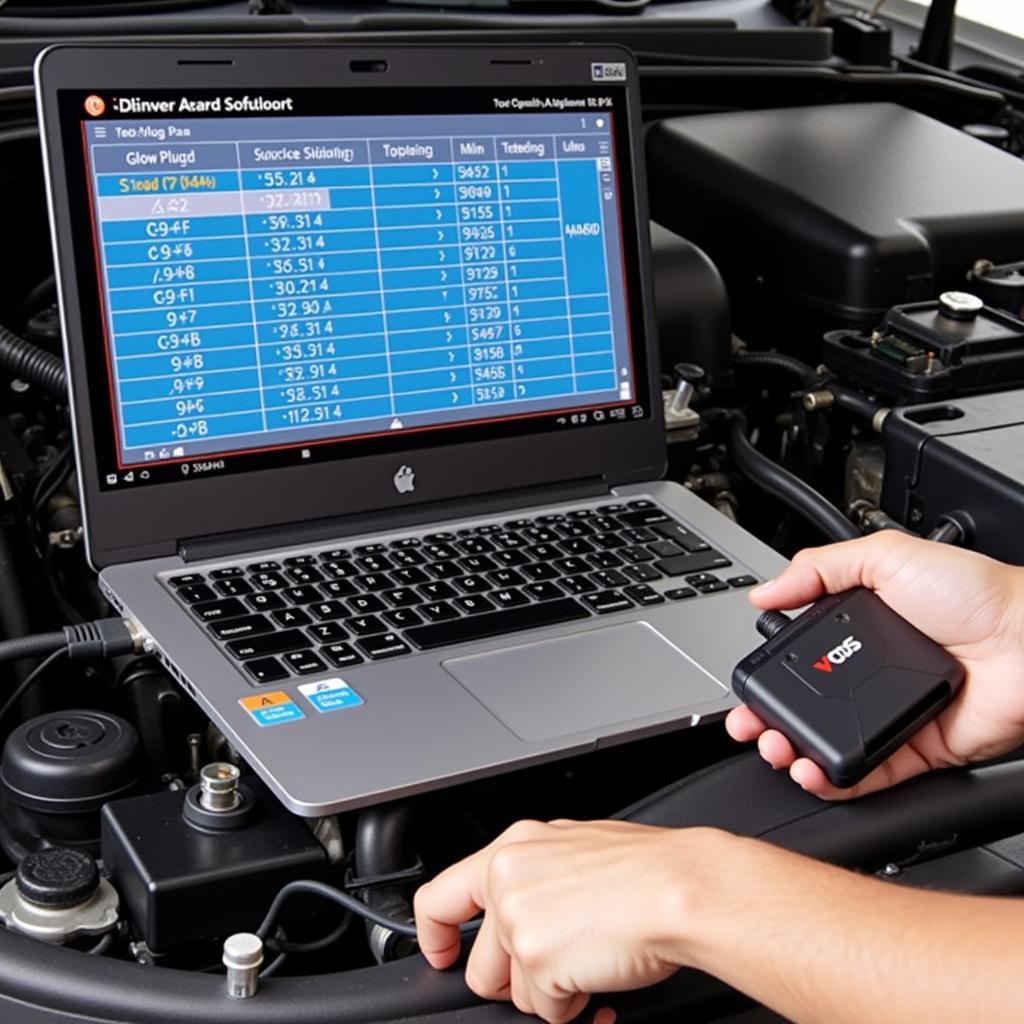Checking your glow plugs is crucial for a smooth cold start, especially in diesel engines. Using VCDS (Vag-Com Diagnostic System), you can effectively diagnose faulty glow plugs without guesswork. This comprehensive guide will walk you through the process of how to check glow plugs with VCDS, covering everything from understanding the basics to interpreting the results.
Understanding the role of glow plugs is the first step. They preheat the combustion chamber, enabling a reliable start in cold weather. A faulty glow plug can lead to rough idling, hard starting, and increased emissions. Using VCDS allows for a precise diagnosis, pinpointing the exact problematic glow plug, saving you time and money. For example, you might have seen articles related to vw t4 vcds which demonstrate the versatility of this diagnostic tool.
Understanding the Importance of Glow Plug Diagnostics
Glow plugs are essential for diesel engines, especially in colder climates. They heat the combustion chamber, allowing the fuel to ignite properly. Without functioning glow plugs, your diesel engine might struggle to start, especially on cold mornings. VCDS offers a detailed diagnostic approach, identifying specific faulty glow plugs, avoiding unnecessary replacements.
Identifying Symptoms of Faulty Glow Plugs
Common symptoms include difficulty starting in cold weather, rough idling after startup, and excessive white smoke during startup. Also, you might experience decreased fuel efficiency and increased emissions. Identifying these symptoms early is crucial to prevent further engine problems. However, these symptoms can also be caused by other issues, so using VCDS to confirm faulty glow plugs is essential. What if your car is a 2001 Jetta TDI? You might wonder what is vcds code reader for 2001 jetta tdi. This diagnostic system is compatible with a wide range of Volkswagen models, including your Jetta.
 Checking Glow Plugs with VCDS Software
Checking Glow Plugs with VCDS Software
Step-by-Step Guide: How to Check Glow Plugs with VCDS
- Connect VCDS to your vehicle: Locate the OBD-II port, usually under the dashboard on the driver’s side. Connect the VCDS cable to the port and to your laptop.
- Turn on the ignition: Turn the key to the “on” position, but do not start the engine.
- Open VCDS software: Launch the VCDS software on your laptop.
- Select Control Module: Choose “Select Control Module.”
- Choose Engine: Select the engine control module. This is usually labeled as “01 – Engine.”
- Go to Advanced Measuring Values: Navigate to “Advanced Measuring Values” or “Measuring Blocks.”
- Find Glow Plug Readings: Locate the measuring block group that displays glow plug readings. This may vary depending on the specific engine code. Refer to your vehicle’s service manual for the correct measuring block group.
- Interpret the Results: The readings will show the status of each glow plug. A value of “0” typically indicates a faulty glow plug. Other values might represent varying degrees of functionality.
This specific process of checking glow plugs applies to various car models, especially Volkswagen vehicles.
Common VCDS Error Codes Related to Glow Plugs
Understanding VCDS error codes is vital for effective troubleshooting. Several codes relate to glow plugs, such as the common code 03780 vcds. Recognizing these codes helps you narrow down the issue quickly. Each code points to a specific problem, enabling more targeted repairs. Consulting a reliable VCDS error code database is essential for accurate interpretation.
How to Clear Glow Plug Error Codes with VCDS
After replacing a faulty glow plug, clearing the related error codes from the system is essential. This allows the ECU to recognize the repair and function correctly. Within the VCDS software, navigate to the “Fault Codes” section and select “Clear All DTCs” to erase the error codes.
Conclusion: Mastering Glow Plug Diagnostics with VCDS
Using VCDS to check glow plugs provides a precise and efficient diagnostic method. Understanding the process, interpreting the readings, and clearing error codes allows for effective troubleshooting and targeted repairs. By mastering these techniques, you can ensure reliable cold starts and optimal engine performance.
FAQ
- How often should I check my glow plugs with VCDS? It’s recommended to check them annually or if you experience cold starting issues.
- Can I replace glow plugs myself? Yes, with basic mechanical skills and the right tools, you can replace glow plugs yourself.
- What are the signs of a bad glow plug relay? Similar to faulty glow plugs, a bad relay can cause hard starting, especially in cold weather.
- How much does a VCDS scan cost? Owning a VCDS system provides long-term cost savings, but you can also find mechanics who offer VCDS scanning services.
- Is VCDS compatible with all car makes and models? Primarily designed for VAG vehicles (Volkswagen, Audi, Seat, Skoda), some versions offer limited functionality with other makes.
- What is the difference between direct and indirect glow plugs? Direct glow plugs are exposed directly to the combustion chamber, while indirect ones are shielded.
- Can I damage my car by using VCDS incorrectly? While unlikely, using VCDS improperly can potentially affect certain control modules. Always follow instructions carefully.
Need expert assistance? Contact us via Whatsapp: +1 (641) 206-8880, Email: [email protected] or visit us at 276 Reock St, City of Orange, NJ 07050, United States. Our 24/7 customer support team is ready to help. We also have other helpful articles on our website, such as information about troubleshooting specific error codes or general VCDS usage guides.


